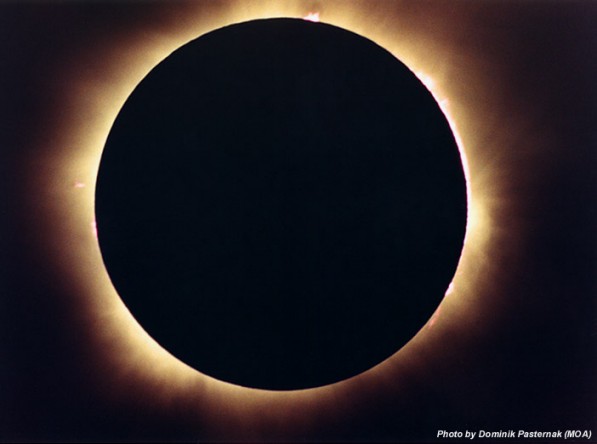
|
Credit & Copyright: Dominik Pasternak
Explanation:
During a total solar eclipse,
Earth's moon blocks the sun -
almost exactly.
While the sun is about 400 times wider than the moon, it is also
about 400 times farther away and each appears to be
half a degree or so in diameter.
On August 11, this remarkable coincidence in the apparent size of two
vastly different celestial bodies produced tantalizing solar
spectacles for denizens of Europe and Asia.
For example, prominences along the sun's limb peer around the
moon's dark edge in
this dramatic picture of totality recorded
as the lunar shadow swept across Hungary.
Subtle structures in the sun's inner corona are also visible
streaming beyond the silhouetted moon.
This total eclipse of the sun was the last to grace planet Earth's
skies for this
millennium.
Although four partial
eclipses will occur in the year 2000, the
next total eclipse will not be until 2001 June 21.
|
January February March April May June July August September October November December |
| |||||||||||||||||||||||||||||||||||||||||||||||||||||||
NASA Web Site Statements, Warnings, and Disclaimers
NASA Official: Jay Norris. Specific rights apply.
A service of: LHEA at NASA / GSFC
& Michigan Tech. U.
Based on Astronomy Picture
Of the Day
Publications with keywords: Sun - corona - solar eclipse - Moon
Publications with words: Sun - corona - solar eclipse - Moon
See also:
- APOD: 2025 August 23 B Fishing for the Moon
- APOD: 2025 July 20 B Lunar Nearside
- APOD: 2025 June 28 B Lunar Farside
- APOD: 2025 June 20 B Major Lunar Standstill 2024 2025
- APOD: 2025 June 18 B Space Station Silhouette on the Moon
- Solar Eclipse
- APOD: 2025 May 21 B International Space Station Crosses the Sun
